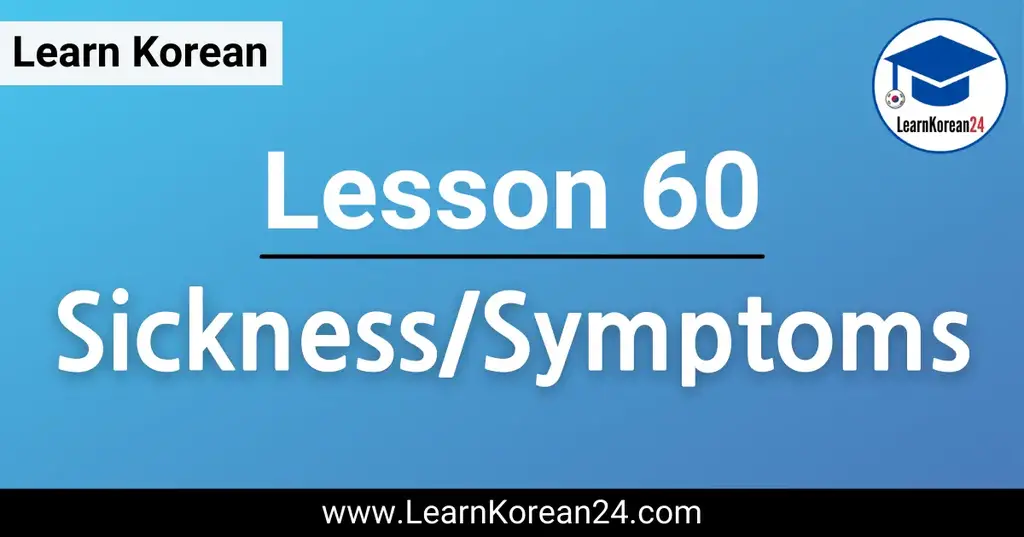Lesson 60: Sickness And Symptoms
In this lesson, you will learn some important verbs and adjectives to do with sickness and symptoms and how to conjugate them correctly. A common mistake Korean language learners make when talking about sickness and symptoms is using the wrong tense. These verbs/adjectives are conjugated in either the present or past tense, but knowing which one to use can be a little tricky.
Lesson 60: Sickness And Symptoms
KEY INFORMATION
Sickness:
걸리다 = to catch
다치다 = to be injured
삐다 = to sprain
부러지다 = to break
데다 = to get a burn
베이다 = to get a cut
Symptoms:
나다 = to rise / to come out
아프다 = to be hurting
따갑다 = to sting
가렵다 = to be itchy
건조하다 = to be dry
붓다 = to swell
막히다 = to be blocked
멍이 들다 = get a bruise
Expressing Sickness
In English, when you want to talk about your sickness and tell someone what is wrong with you, the past tense is often used. For example,
A: “What’s wrong with you?”
B: “I caught a cold.“
Although this is in the past tense, it is not describing a past illness, but rather the person’s current state of sickness. In Korean, the past tense form (았/었) is also used when talking about being in a state of sickness. Let’s look at some examples.
걸리다
걸리다 is a verb that means ‘to catch‘ and is used to say that you have caught or developed a disease or medical condition. For example, “I caught a cold.“, “I got food poisoning.“, etc. When using 걸리다 to describe a state of being ill, the past tense form (걸렸어요) is always used. As was mentioned above, this past tense form (았/었) does not actually express the past tense. Instead, it expresses the situation that now exists as a result of something that happened in the past (i.e., I have a cold now as a result of being infected with the cold virus in the past.). Here are some more examples:
감기에 걸렸어요. = I caught/have a cold.
독감에 걸렸어요. = I caught/have the flu.
식중독에 걸렸어요. = I have/got food poisoning.
눈병에 걸렸어요. = I have/got an eye infection.
암에 걸렸어요. = I have/got cancer.
장염에 걸렸어요. = I have/got enteritis.
변비에 걸렸어요. = I have/got constipation.
다치다
다치다 is a verb that means ‘to be injured’ and is often used when you are hit by something or someone, which causes your body or body part to be injured. 다쳤어요 is the past tense form of 다치다 and is used when describing a person’s current state of being injured. Here are some examples:
친구가 다쳤어요. = My friend got injured.
다리를 다쳤어요. = I hurt my leg.
팔을 다쳤어요. = I hurt my arm.
허리를 다쳤어요. = I hurt my back.
무릎을 다쳤어요. = I hurt my knee.
More Verbs To Express Sickness
Of course, there are other, more specific ways in which you might be sick or injured, such as getting a sprain, breaking bones, getting burned, etc. Here are the verbs you will need to know to express these types of sickness/injuries. Just like the above verbs, they are used in the past tense when talking about a person’s current state of sickness/injury.
삐다 = to sprain
발목을 삐었어요. = I sprained my ankle.
부러지다 = to break
다리가 부러졌어요. = I broke my leg.
데다 = to get a burn
손을 데었어요. = I burned my hand.
베이다 = to get a cut
손가락을 베였어요. = I cut my finger.
Expressing Symptoms
In English, when a person describes their symptoms, they often use the present tense. For example, “My head hurts.“, “I have a runny nose.“, etc. In Korean, the present tense is also used when describing symptoms. Let’s look at some examples.
아프다
아프다 is an adjective which means ‘to be hurting’. It is often used when describing the symptom of feeling pain or suffering. When describing the symptom of pain using 아프다, the present tense form (아파요) is used. Here are some example sentences:
머리가 아파요. = My head hurts.
목이 아파요. = My neck hurts. / I have a sore throat.
배가 아파요. = My stomach hurts.
허리가 아파요. = My back hurts.
다리가 아파요. = My leg hurts.
나다
나다 is a verb that means ‘to rise above the surface of the body or the ground.’ This verb is often used when describing a symptom or disease that is developing in your body. When describing a symptom/disease that is developing, the present tense form 나요 is used. Here are some examples:
열이 나요. = I have a fever.
땀이 나요. = I’m sweating.
피가 나요. = I’m bleeding.
콧물이 나요. = I have a runny nose.
두드러기가 나요. = I have a rash.
기침이 나요. = I have a cough.
재채기가 나요. = I am sneezing.
딸꾹질이 나요. = I have the hiccups.
구토가 나요. = I am throwing up.
설사가 나요. = I have diarrhea.
More Verbs To Express Symptoms
Of course, there are many more symptoms one might have. Here are some more verbs and adjectives you can use to describe symptoms.
따갑다 = to be sore
눈이 따가워요. = I have sore eyes.
가렵다 = to be itchy
피부가 가려워요. = I have itchy skin.
건조하다 = to be dry
목이 건조해요. = I have a dry throat.
*붓다 = to swell
입술이 부었어요. = I have swollen lips.
*막히다 = to be blocked
코가 막혔어요. = My nose is blocked.
*멍이 들다 = to get a bruise
팔에 멍이 들었어요. = My arm is bruised.
*These verbs are always used in the past tense when talking about one’s symptoms.
STUDY ONLINE WITH KOREAN ARAH!
Ready to take your Korean to the next level?
Get One-on-One Korean lessons from a qualified and experienced Korean language tutor!

